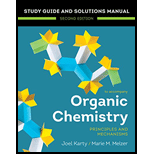
Concept explainers
(a)
Interpretation:
The structure of the
Concept introduction:
Methyl esters can be prepared from the carboxylic acid when reacted with diazomethane. The negatively charged oxygen of the carboxylate ion formed by deprotonation of carboxylic acid acts as a nucleophile. The carbon atom of diazomethane is converted to an electron-poor site by protonation. The reaction proceeds via
(b)
Interpretation:
The structure of the carboxylic acid that can be reacted with diazomethane to form the given methyl ester is to be drawn.
Concept introduction:
Methyl esters can be prepared from the carboxylic acid when reacted with diazomethane. The negatively charged oxygen of the carboxylate ion formed by deprotonation of carboxylic acid acts as a nucleophile. The carbon atom of diazomethane is converted to an electron-poor site by protonation. The reaction proceeds via
(c)
Interpretation:
The structure of the carboxylic acid that can be reacted with diazomethane to form the given methyl ester is to be drawn.
Concept introduction:
Methyl esters can be prepared from the carboxylic acid when reacted with diazomethane. The negatively charged oxygen of the carboxylate ion formed by deprotonation of carboxylic acid acts as a nucleophile. The carbon atom of diazomethane is converted to an electron-poor site by protonation. The reaction proceeds via
Want to see the full answer?
Check out a sample textbook solution
Chapter 10 Solutions
Organic Chemistry: Principles And Mechanisms: Study Guide/solutions Manual (second)
- Complete the reaction map with the choices given.arrow_forwardTo produce an amine which is shorter by one carbon atom, the hand, is used to produce an arene. reaction is employed. On the otherarrow_forwardGive a clear explanation handwritten answer..complete the following reaction with explanationarrow_forward
- Identify the electrophile and the nucleophile in each of the following reaction steps. Then draw curved arrows to illustrate the bond-making and bond-breaking processes.arrow_forwardReaction Method: Reaction Mechanism Sublimation, Elimination, Reaction with Metal, Ester Formation, Oxidation Based on the different methods of reactions, which is the most environmentally friendly and least harmful of them all? Kindly explain briefly. tyarrow_forwarde) why are they organic products in the reactions from (chemical equation for acid base reaction of benzyl alcohol and potassium hydroxide) and (Chemical equation for an acid base reaction of Ethanethiol and sodium hydroxide) more soluble in water compared to the organic reactants?arrow_forward
 ChemistryChemistryISBN:9781305957404Author:Steven S. Zumdahl, Susan A. Zumdahl, Donald J. DeCostePublisher:Cengage Learning
ChemistryChemistryISBN:9781305957404Author:Steven S. Zumdahl, Susan A. Zumdahl, Donald J. DeCostePublisher:Cengage Learning ChemistryChemistryISBN:9781259911156Author:Raymond Chang Dr., Jason Overby ProfessorPublisher:McGraw-Hill Education
ChemistryChemistryISBN:9781259911156Author:Raymond Chang Dr., Jason Overby ProfessorPublisher:McGraw-Hill Education Principles of Instrumental AnalysisChemistryISBN:9781305577213Author:Douglas A. Skoog, F. James Holler, Stanley R. CrouchPublisher:Cengage Learning
Principles of Instrumental AnalysisChemistryISBN:9781305577213Author:Douglas A. Skoog, F. James Holler, Stanley R. CrouchPublisher:Cengage Learning Organic ChemistryChemistryISBN:9780078021558Author:Janice Gorzynski Smith Dr.Publisher:McGraw-Hill Education
Organic ChemistryChemistryISBN:9780078021558Author:Janice Gorzynski Smith Dr.Publisher:McGraw-Hill Education Chemistry: Principles and ReactionsChemistryISBN:9781305079373Author:William L. Masterton, Cecile N. HurleyPublisher:Cengage Learning
Chemistry: Principles and ReactionsChemistryISBN:9781305079373Author:William L. Masterton, Cecile N. HurleyPublisher:Cengage Learning Elementary Principles of Chemical Processes, Bind...ChemistryISBN:9781118431221Author:Richard M. Felder, Ronald W. Rousseau, Lisa G. BullardPublisher:WILEY
Elementary Principles of Chemical Processes, Bind...ChemistryISBN:9781118431221Author:Richard M. Felder, Ronald W. Rousseau, Lisa G. BullardPublisher:WILEY





